Stakeholder entities
Overview
Stakeholders entities can be modified in the Expert view using the options mentioned below. Bear in mind that these entities can be created and configured from the Experience design view. Some options are shown right-clicking a Stakeholder entity, or some others selecting one of the nodes of the Stakeholder entity.
Right-click options
When a Stakeholder entity is selected, the following options are shown:
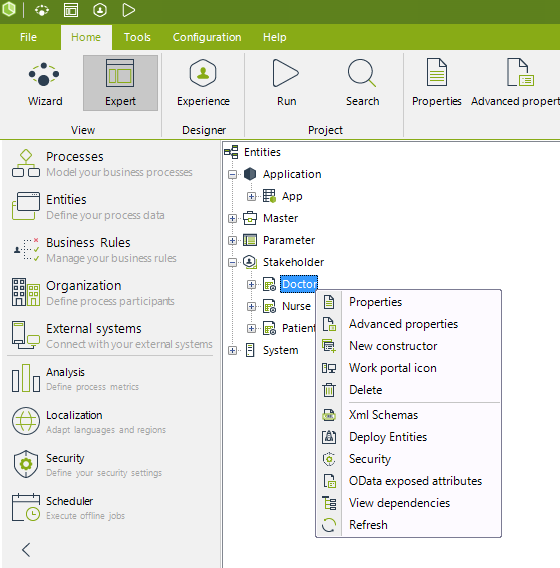
| Option | Detail |
|---|---|
| Properties | This is the same wizard to create and modify entities as the one used in the second step of the process wizard (Model Data). This allows to edit the display name of the entity and its attributes. The name can be modified but you must also change its corresponding dependencies. |
| Advanced properties | |
| Forms | |
| Display Form | Is the form used to display the information of the entity when managing it in the Work Portal using the Admin > Stakeholders option. The controls added to the form will become columns of the table in the Work Portal. |
| Add Form | Is the form used to add a new Stakeholder, when managing it in the Work Portal using the Admin > Stakeholders option. The controls added to the form will always be accompanied by a Search control linked to the users entity. |
| Edit Form | Is the form used to edit a Stakeholder, when managing it in the Work Portal using the Admin > Stakeholders option. The controls added to the form will always be accompanied by a Search control linked to the users entity. |
| Log | Enables the possibility to register operations to Bizagi log. By default this option is NOT selected. |
| Business key | Allows the addition of Business keys for this entity. |
| Inheritance | Allows you to select the parent of the selected entity. |
| Mapping | This list allows the automatic injection of data from the current entity. |
| New constructor | The way to create new registries in the entity directly from the Work Portal is configured during this wizard. |
| Work Portal icon | By default, every Entity Action displays a briefcase icon, you can change this icon using this option selecting one of the Bizagi Icons. |
| Delete | Deletes the entity. This can only be done if the entity is not related in any way with other elements within the project. |
| Xml schemas | This option is used to generate the schema used by third party services to manipulate Bizagi Web Services endpoints. |
| Security | This option is used to configure the security of the element. |
| OData exposed attributes | Customize which information is returned whenever invoking Bizagi OData API services. |
| View dependencies | This option is used to verify if the entity is being used by any other form, rule, entity, or element; this option lists in a hierarchical way all the dependencies of the entity. |
| Refresh | Refresh the information of the entity. Useful when working in a collaborative environment. |
Nodes
When a Stakeholder entity is expanded, the following nodes are shown:
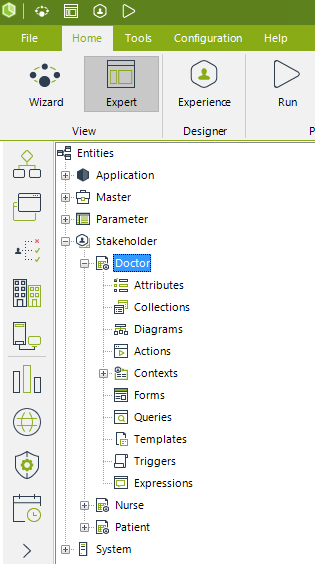
Each node displays the following information:
- Attributes
- Collections
- Diagrams
- Actions
- Contexts
- Forms
- Queries
- Templates
- Triggers
- Expressions
Attributes
The Attributes node contains all the attributes of the entity filtered by data type. The data types considered as attributes are the common types (Boolean, currency, date time, file, string...) and one-to-one relationships with other entities. Each attribute has a name, a display name (which is the one used in the Work Portal) and its data type. When the data type is Entity, a Related entity is shown. Lastly, the Dpl column shows if the attribute is considered in deployment.
When the node is selected, the Ribbon will display the following options:

- Edit attributes: This option will display the Entity edition wizard in its second step. Allowing the user to modify, add or even delete attributes and relations, and their advanced properties.
- New relationship: This option will add the specified relationship between the entities selected.
- Refresh: This option will reload the information stored from the database, refreshing the attributes listed.
Collections
The Collections node contains all the one-to-multiple relationships of the entity. Each collection has a name, a display name (which is the one used in the Work Portal) and its related entity.
The Display in Me check allows the entity to be displayed in the My Stuff menu.
If a collection has been marked with the "Enable Add Button" option, then an option to add registries will be shown at the top of the results of a search or the values in Me Menu > My Stuff.

Any relationship can be attached to a context directly from the Master > Entities view, right-clicking the collection to attach:
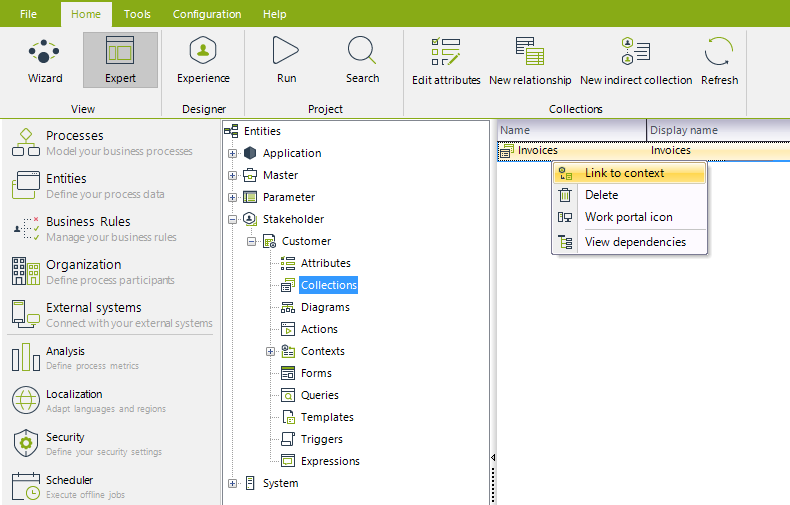
When the node is selected, the Ribbon will display the following options:
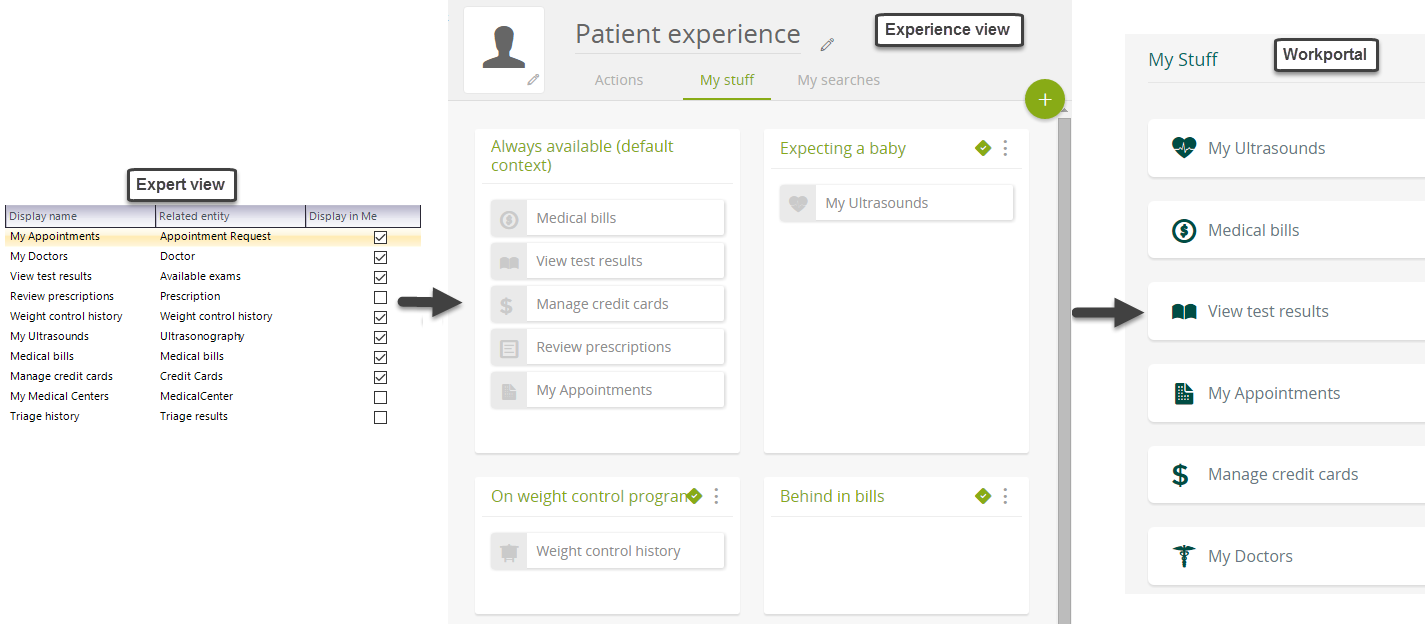
- Edit attributes: This option will display the Entity edition wizard in its second step. Allowing the user to modify, add or even delete attributes and relations, and their advanced properties.
- New relationship: This option will add the specified relationship between the entities selected.
- New indirect collection: this option will create an indirect relationship for the current entity.
- Refresh: This option will reload the information stored from the database, refreshing the collections listed.
Diagrams
The Diagrams node contains all the diagrams modeled for this entity. There is no limitation on how many diagrams can be created under a node.
The diagram does not have to have the entity from which the node is child of. Nonetheless, it is highly advisable to include the entity since it will help with the approach of your project.
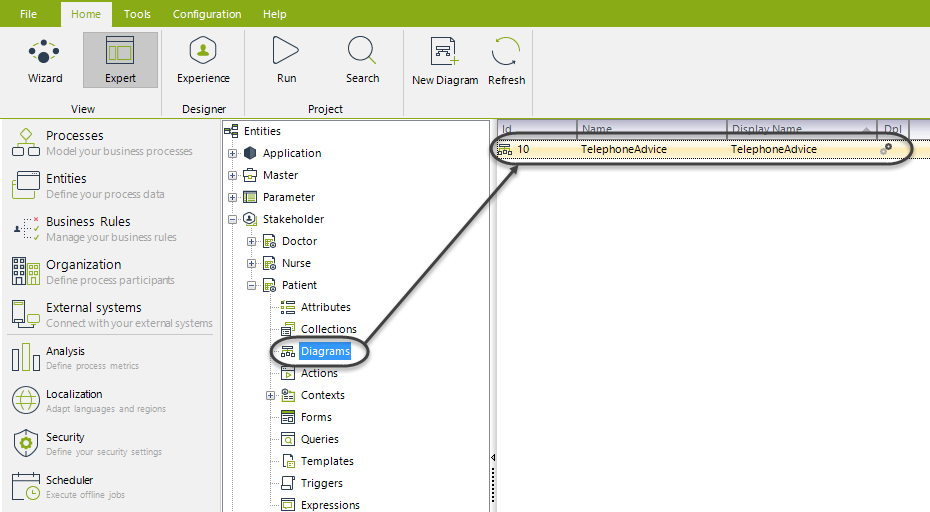
When the node is selected, the Ribbon will display the following options:
- New Diagram: This option will add a new blank diagram to the entity.
- Refresh: This option will reload the information stored from the database, refreshing the diagrams listed.
Actions
The Actions node contains all the Actions defined for this entity. Hence, these actions can be executed selecting the entity in My Stuff section of the Me Menu, or executed from a Process.
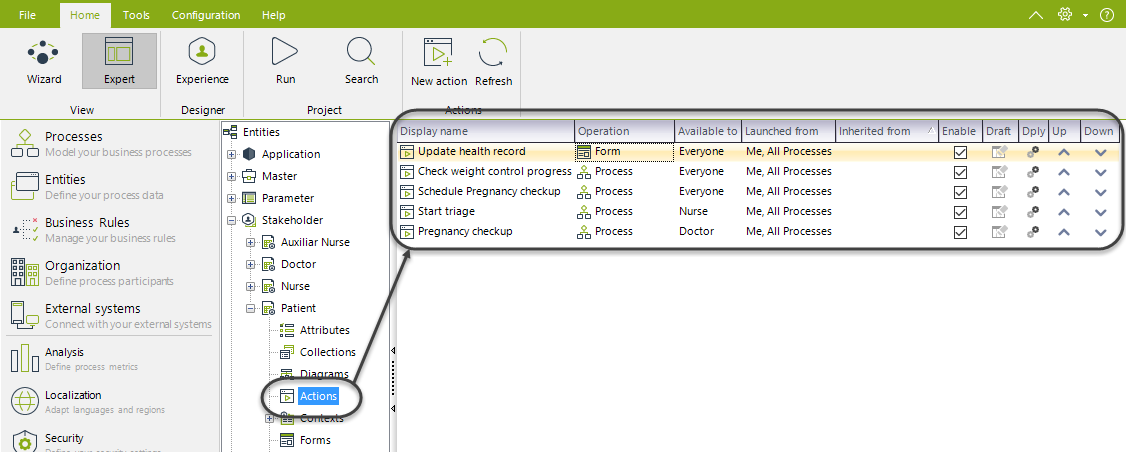
When the node is selected, the Ribbon will display the following options:
- New Action: This option will start the Actions Advanced Configuration menu to add a new Action for the current entity.
- Refresh: This option will reload the information stored from the database, refreshing the Actions listed.
Contexts
Every context designed for the Stakeholder will be listed as a children of the Contexts node of said Stakeholder.
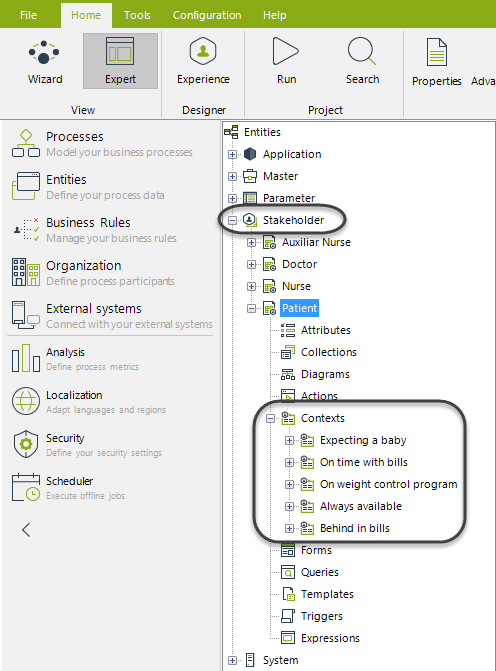
When selected or right-clicked, the node will display the following options:
- New context: This option allows the user to create a new context for the current Stakeholder. When selected, the new Context window will be displayed.
- Refresh: This option will reload the information stored from the database, refreshing the Contexts listed.
Forms
The Forms node contains all the Forms defined for this entity. These forms are used in the Work Portal to interact with the final users.
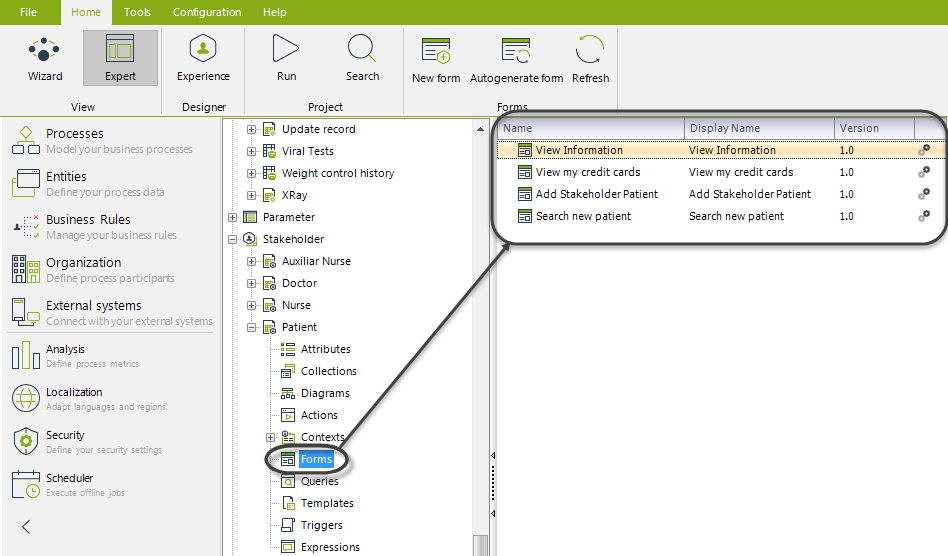
When the node is selected, the Ribbon will display the following options:
- New Form: This option will start the Forms Editor window to add a new Form.
- Autogenerate form: This option will automatically create a Form with all the current Stakeholder information.
- Refresh: This option will reload the information stored from the database, refreshing the Forms listed.
Queries
The Queries node contains all the queries defined for this entity. These queries are called Entity Query Forms they are used in the Work Portal to interact with the final users.
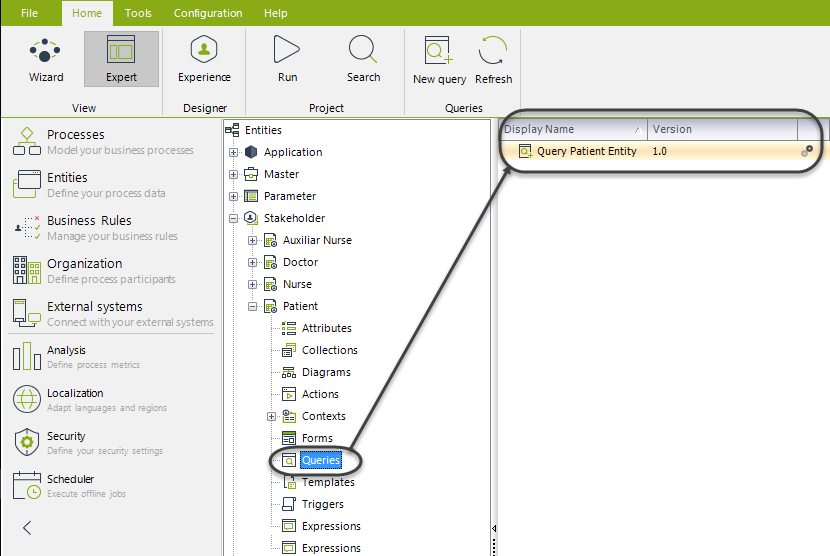
When the node is selected, the Ribbon will display the following options:
- New query: This option will start the Forms Editor window to add a Query Form.
- Refresh: This option will reload the information stored from the database, refreshing the queries listed.
Templates
The Templates node contains all the templates defined for this entity. These templates are used in the Work Portal to interact with the final users.
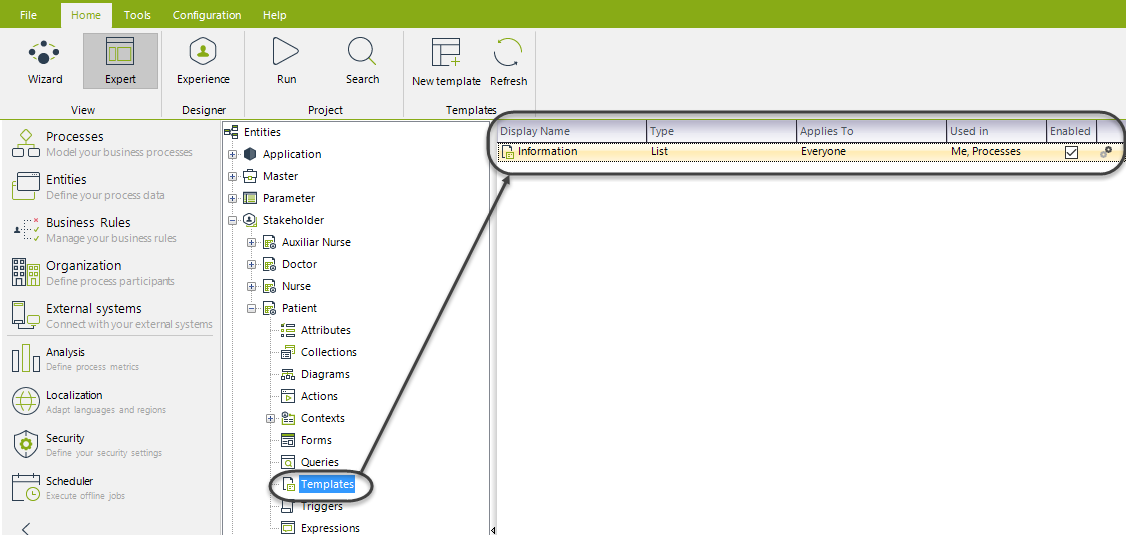
When the node is selected, the Ribbon will display the following options:
- New template: This option will start the Template Configuration window to add a Data Template.
- Refresh: This option will reload the information stored from the database, refreshing the templates listed.
Triggers
The Triggers node contains all the triggers defined for this entity. These triggers are data-based actions.

When the node is selected, the Ribbon will display the following options:
- New trigger: This option will start the Trigger Configuration window to add a Trigger.
- Refresh: This option will reload the information stored from the database, refreshing the triggers listed.
Expressions
The Expressions node contains all the expressions defined for this entity.
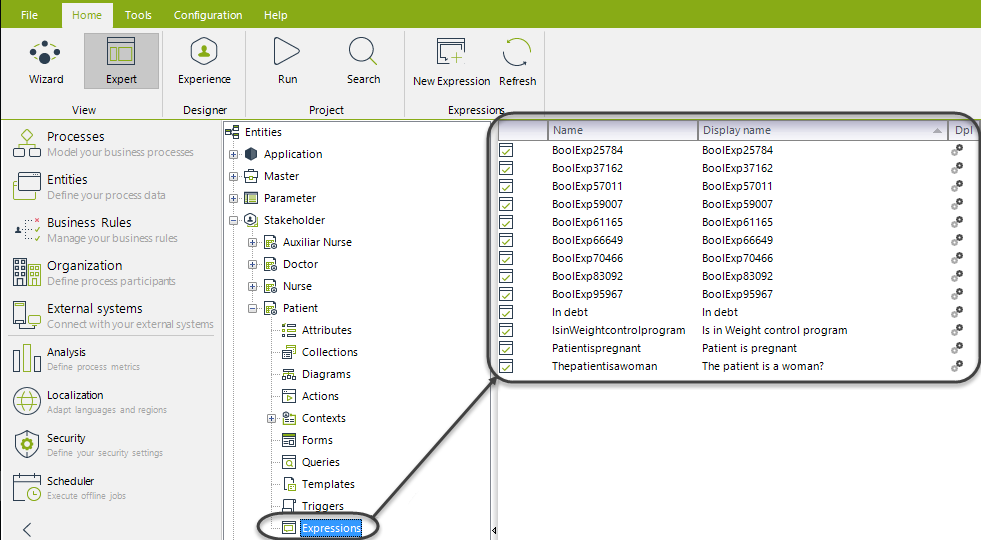
When the node is selected, the Ribbon will display the following options:
- New expression: This option will start the Expression Configuration window to add an Expression.
- Refresh: This option will reload the information stored from the database, refreshing the expressions listed.